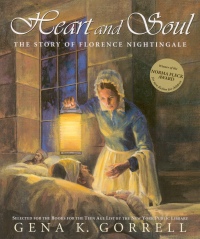| ________________
CM . . .
. Volume XII Number 1 . . . .September 2, 2005
Florence Nightingale was a woman of her time and ours. It is easy to envision her ministering to Crimean troops under the harshest of conditions and, at same time, using a lap top computer to organize her board meetings or arrange for the transportation of goods and services to overseas markets. Like many complex individuals, her strengths were also her weaknesses. In Gena K. Gorrell's multi-layered portrayal, we see that Nightingale did a great deal to advance the public's perception of women in positions of responsibility through her extreme organizational skills, discipline, political savvy, dedication, logic, and what we would today call professionalism. She succeeded despite character flaws, such as being demanding, insensitive, obsessive, rigid, and bad tempered. For this reason, the author's well-researched book gives the reader a balanced view both of the times of Nightingale and her personality. Her flaws and strengths mirror those of the world in which she lived. Gorrell skillfully manages to inform her readers without burdening them with facts and detail. The curious student will be inspired to read on whereas the average reader will be both informed and entertained. The text gives a well-researched view of the times by giving a good sense of the politics, society, and technology of the period and the effect all three had on people's lives and perspectives. Nightingale's era was one of scientific and technological progress, but social strictures often prevented these benefits from improving the lives of the average citizen. Readers learn, for example, that:
But in one overseas British hospital:
Class and gender divisions affected the quality of people's lives. For women of intelligence during this time period, there were few choices, and those choices were further affected by class distinctions. The author gives readers a strong sense of Nightingale's world, i.e., that it was narrow and "shallow" for a woman of her intelligence, and readers come to understand that Nightingale felt that she was a "monster" because she was "different." While she was "highly intelligent and energetic and capable of iron self-discipline," she was, like some privileged women of her time, "delicate," and she was given to both fainting and a strong sense of betrayal when people did not do what she wanted them to do. Both her health and her relationships with people would be affected by her extreme reactions throughout her lifetime. Through a series of events, Nightingale would eventually be able to put her intelligence to good work to develop hospital care both at home and in places like the Crimea where conditions were unrelentingly harsh for the British soldiers who fought there. Her observations, reforms, and meticulous improvements would eventually affect the way hospitals were run in the British Empire and how nursing would, through her guidelines and training, come to seen as the profession it is today. Due to the social, historical, political, technological context in which Nightingale is placed, this well written and entertaining book would be useful to more mature students who are studying social sciences, geography, health sciences, or history. An interesting aide to the story of the book is in its design. The off-white paper, the use of engravings as well as old photographs and elaborate drop caps and slightly old fashioned font in addition to other design details give one a sense of the era. This ornamentation is judiciously used leaving the text easy to read and is an interesting contrast to the harsh conditions in which some people of the time lived. One is left with the impression of Nightingale as a determined woman who helped change her society and ours, and as someone who overcame social stigma and direct opposition to achieve numerous outstanding goals. She, after so many generations, remains a role model. The source notes section and the selected bibliography are helpful for students, but the index could have been more detailed considering the breadth of the topics covered in the book. This book is highly recommended for students aged 15 and older. Highly Recommended. J. Lynn Fraser has written two guided reading books for grade six readers, and her articles appear in international magazines and newspapers.
To comment
on this title or this review, send mail to cm@umanitoba.ca.
Copyright © the Manitoba Library Association. Reproduction for personal
use is permitted only if this copyright notice is maintained. Any
other reproduction is prohibited without permission.
NEXT REVIEW |
TABLE OF CONTENTS FOR THIS ISSUE
- September 2, 2005.
AUTHORS |
TITLES |
MEDIA REVIEWS |
PROFILES |
BACK ISSUES |
SEARCH |
CMARCHIVE |
HOME |
